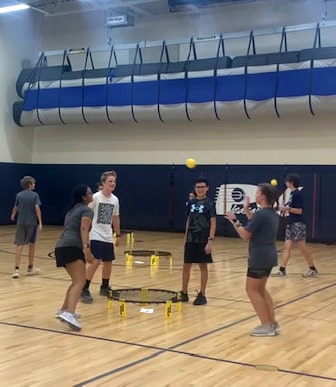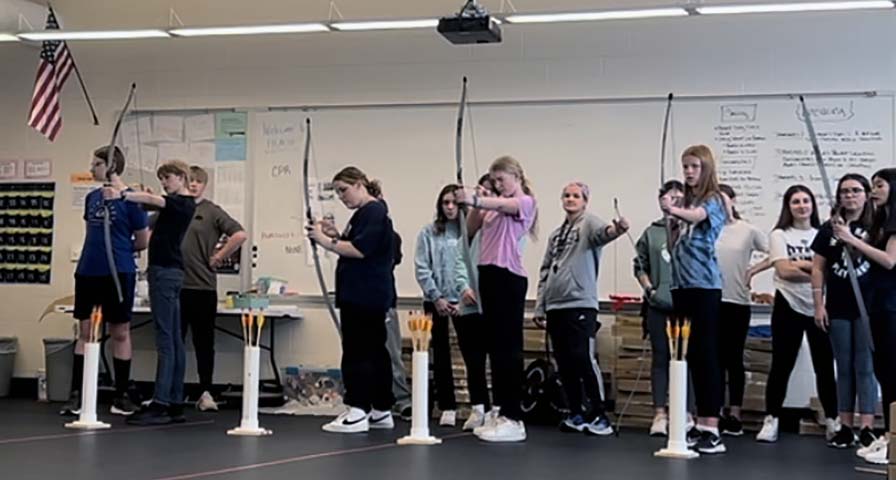
Instant Feedback, Choice of Activities Create ‘Excitement’ and Improve Achievement in District Teacher of the Year’s Program
By tying activities to heart rate-based goals, the physical education team at Pleasant Valley Junior High School (Iowa) ensures students understand why it’s important that they give their best effort during class.
“Whether students are playing ping pong or team handball or paddle slam, we set goals so they can see how their heart rate is impacted,” Caitlin Schoville, the 2024 SHAPE America Central District Middle School PE Teacher of the Year, said. “That’s one of the biggest things we talk about: determining what heart rate is based on the activity.”
Schoville and her colleagues use spirit heart rate monitors to provide real-time, personalized feedback to each student.
“We use the monitors every day,” Schoville said. “It’s one of the things we love.”
The monitors track student heart rate throughout class, showing students both their actual heart rate and the heart rate zone, they are exercising in at any moment:
- Blue indicates a resting heart rate tied to low activity levels
- Yellow indicates an elevated heart rate tied to moderate activity levels
- Red indicates a highly elevated heart rate tied to vigorous activity levels
Working with Heart Rate Monitors
Students know they are wearing monitors for each class, and teachers make sure that goals for time spent exercising in each heart rate zone reflect the goals of each activity. Teachers want students to stay in the blue zone during a yoga session but expect them to get into the yellow or red for other more intense activities. Students get to choose their activities. Then it’s up to them to make the most of the participation.
“When we give them choices, we give them 1 team/competitive unit, 1 lifetime fitness unit and 1 individualized unit,” Schoville explained. “We want them to have success in what they enjoy.”
In recent years, Pleasant Valley has added units for weightlifting, archery and Ultimate Paddle Zlam to its program.
“We are not complacent,” Schoville said. “Our PE department values always being on top of what’s new and what’s coming out. We are always looking for things students like to do that will get their heart rates up. We added several new units this year.”
Neither weights nor archery are new activities. They’re just new to the PVJH PE curriculum. Schoville said both are lifetime activities that students can stick with, and – perhaps more importantly in the short term – they provide students with very different interests a connection to class.
“We added archery, which allowed us to get students to buy in who don’t really enjoy physical activity and movement,” Schoville said. “A few students who despise PE and movement in general signed up because they felt it could be less physically challenging. You can see them light up. They have more pep in their step during warmup because they knew they would be doing something cool and new that they haven’t done before.”
And that opens the door for conversations with students who previously chose not to participate or engage.
“It’s great to see them excited,” Schoville said. “And the archery gives us a chance to talk and teach them to focus and calm their breathing. Being in the red (heart rate) zone will not help you focus on the target and shoot well.”
Conversations Focused on Long-Term Health and Fitness
While the teachers want students to enjoy the activities they can choose for class, they also make sure students understand what it takes to make each activity beneficial for their cardiovascular health and fitness.
One key, Schoville said, is for students to make the most of the warmup period before they break off into their chosen activities.
“If you have a strong heart, then you need to work to your ability level during our warmup – the first 10 minutes of class is all about cardiovascular and muscular endurance,” Schoville said. “So, everyone’s warm up level may look different. The higher you get your heart rate during warm-up, you can keep that up throughout the class.”
Conversations after class include the heart rate reports students see and receive via email. Immediately upon returning their IHT ZONE monitor, students see a snapshot on Schoville’s computer that shows them whether they met their heart rate goals for the day. The summary email goes into more detail, including:
- A graph of the student’s heart rate throughout the session;
- A bar graph of minutes spent in each heart rate zone; and
- Totals of minutes spent exercising in each heart rate zone
“We look at those charts and see what we do,” Schoville said. “What can we do better? Why did we do well? That’s been really good for us the last few years. It’s gotten us a lot of buy-in (from students).”
Teachers also talk with students about making sure they are focused on themselves and not on their fellow students. Focusing on heart rate allows each student to work toward individual goals. Schoville said students are taught to look at PE like they would other content areas at school: math, reading, English, etc.
“It’s a huge telling point for our students,” she said. “In all of our content areas we are at different levels, whether that’s math, reading or PE. We can’t see heart comparisons. I think that conversation is really good. They can see where some kids are compared to them, but is that the true picture? We compare it to weightlifting. Do you lift the same as other students? No. The heart is the same thing. You work to your level and not to anyone else’s.”
Rewarding Students for High Achievement
Schoville and her colleagues are doing more with the summary reports than going over them with each student. This year, they began printing reports for all 950 students. To give students added motivation, the top 100 students with the most minutes in the target heart rate zones get a reward.
“For the top 100 for each quarter, they get a ‘sign up first’ pass when it comes time to choose the next units we are working on,” Schoville said. “It’s motivating them to go above and beyond, and it’s nice to see. We have them challenging each other to see if they can get more minutes.”
It’s one more way teachers are encouraging students to make the most of each exercise opportunity.
“Our students do a great job challenging themselves and each other to reach the next (fitness zone),” Schoville said. “We don’t want students to struggle. We want them to reach their level of success.”


